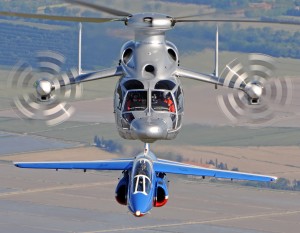From an Airbus press release:
After opening the frontiers of flight during a record-setting test program, Airbus Helicopters’ X3 is now ready for its place in history as this high-speed helicopter demonstrator is welcomed for display at the French national musée de l’Air et de l’Espace (Air and Space museum) of Paris-Le Bourget.
The X3 will be exhibited in the musée de l’Air et de l’Espace’s hangar facilities at Paris-Le Bourget airport, being strategically located with other high-speed legends – Europe’s supersonic Concorde jetliners.
“We welcome this illustrious addition to France’s leading aviation museum, where our collection includes other historic rotorcraft from Airbus Helicopters’ lineage – like the S.A. 3210-01 Super Frelon, which 50 years earlier set a world speed record of 350 km/hr,” explained Catherine Maunoury, CEO of the musée de l’Air et de l’Espace and twice world aerobatics champion. “The X3 continues a tradition of excellence at Airbus Helicopters, building on decades of innovation, research and development.”
Airbus Helicopters pursued the X3 development as part of self-funded company efforts to evolve rotorcraft that offer new ways to perform missions, fly faster and farther, and reduce operating and maintenance costs. The X3, known as a hybrid helicopter, demonstrated the company’s high-speed, long-range, Hybrid Helicopter (H3) concept.
“It is appropriate that the X3 is joining other renowned aircraft at the Musée de l’Air et de l’Espace that have helped shape the aviation industry, especially since from its conception, it showed Airbus Helicopters’ entrepreneurial drive to deliver a viable demonstrator to serve our customers’ high-speed requirements,” said Airbus Helicopters Executive Vice President Global Business & Services, Dominique Maudet.
From its maiden take-off in September 2010 to its retirement in 2013, the X3 fully validated Airbus Helicopters’ hybrid concept, using a pair of turboshaft engines to power both a five-blade helicopter main rotor and two propellers installed on short-span fixed wings.
During more than 155 hours logged by the aircraft in 199 flights, milestones achieved included a level flight speed of 255 knots (472 km/hr) on June 7, 2013 – surpassing previous high speeds reached by a helicopter. While exploring the full flight envelope in cruise, climb, at altitude and during descent, the X3 validated this high-speed concept’s qualities – including outstanding stability, intuitive piloting characteristics, as well as low vibration levels without the need for anti-vibration systems.
The X3 also served as an ambassador of innovation during a demo tour in the U.S. in the summer of 2012 to demonstrate this advanced high-speed transportation system’s unique operational capabilities for both civil and military operators. The final stop at Washington D.C., where the X3 landed on the helipad of the Pentagon, marked a symbolic moment in the X3’s frontier-pushing history. Three months later, the X3 was in the spotlight at the ILA Berlin air show where it participated in flight demonstrations and gave European aficionados an up-close look at its unique characteristics.
Airbus Helicopters foresees a wide range of potential applications for a hybrid helicopter configuration that may be developed from the X3 concept, offering an advanced, cost-effective vertical takeoff and landing (VTOL) transportation system with speeds of a turboprop-powered aircraft and the full-flight capabilities of a helicopter. Its applications could include long-distance search and rescue (SAR) operations, coast guard missions, border patrol flights, passenger transport and off-shore airlift, along with inter-city shuttle services.
The combination of higher cruise speeds and excellent VTOL performance also is well-suited for military missions, such as special forces operations, troop transport, combat SAR and medical evacuation. The X3 concept is particularly well suited for missions requiring long transit flights at high speeds, while retaining full vertical lift and hover capabilities – all at a very affordable cost.
The X3 resulted from a rapid-paced program that utilized one of Airbus Helicopters’ Dauphin helicopters as the airframe, providing a test platform with a maximum take-off weight of 5,200 kg. In addition to the more symbolic aspect of achieving record velocities for a rotorcraft, the X3’s flight evaluations enabled Airbus Helicopters to further explore the behavior of main rotors at high speeds, while also assessing the effectiveness in drag optimization.
